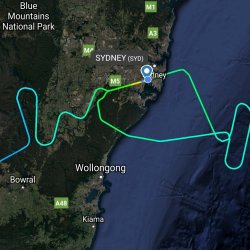This was our approach, go-around and subsequent landing into SYD on QF2 last Wednesday during the fowl weather. My first landing on the east-west runway at SYD in an A380 resulted in my first go-around in an A380 - wow! Never felt power quite like that in an aircraft! It was a "late" go-around I think, as we were very close to touching down when you could feel a huge gust of wind push the aircraft left. Then the power came on and we were out of there. Amazing. We then circled out at sea whilst deciding whether to divert to MEL or try again. In the end, we got in.
There are a couple of different types of go around that you might have experienced. A normal go around, which can happen for any number of reasons, will have the power initially being pushed to TO/GA, but then a second or two later being reduced. The system will then target whatever power is needed for a 2,000 fpm rate of climb.
But, as it was so windy, it's likely that it was a windshear go around, in which case the power is simply left at 100%
As you'd departed Singapore, the take off power used there would have been around 70%. So now the aircraft is about 100 tonnes lighter, and you're seeing what 100% looks like.
Just wondering on a really windy, rainy day like that, do you take over from the auto pilot earlier than on a dry day when on approach, or leave it on as long as you can?
The autopilot handles wind quite well, but it's less capable with gusts. You take it off the a/p if it reaches a point at which you think you can do better...and that point varies on every approach. Personally, I'd probably take it to about 500 feet on a day like that. If you're expecting a go around, it's easier to leave it in as long as you can.
How different is it initiating a go-around when the aircraft is on auto-pilot compared to when flying manually?
You initiate the go around by pushing the thrust levers all the way forward to TO/GA. If the a/p is engaged, then it will pitch up. FO selects one stage less flap. You call what annunciations you see, and FO calls positive climb when you have it. Then gear up, and you're basically back to a take off. If you're manually flying, then you have to do the pitch up. FBW aircraft will not respond to the power increase with a pitch change, so it's a solid pull to get the rotation to about 12º. Earlier aircraft (anything non FBW), will pitch up of their own accord because of the power increase, and you'll generally find you need forward pressure to hold the target attitude.
Is a go-around a completely manual procedure or done by the aircraft at "the push of a button" as it were? How does it work?
It can be either. In a Boeing, pushing the go around switches (TO/GA) will cause the thrust levers to drive to TO/GA, and the flight directors and autopilot to pitch up. A double push on the switch will cause the aircraft to use full power, instead of the power for a 2,000 fpm target. Airbus is similar, except that it's initiated by pushing the thrust levers to their full extent. You decide on whether you want the reduced power, by pulling the power back one notch (MCT) which will give a 'soft' go around. Not really all that soft though.
AV will have to update us on the 737, but I don't think it does autopilot go arounds.
Functionally, it should be identical in both makers' aircraft, in that the thrust levers are at full extent, and either the a/p or the flight directors are commanding a pitch target for a fixed climb speed (roughly the speed you were at). The biggest difference is that you MUST have pushed the levers to the stop in an Airbus, whereas in a Boeing it's possible to have simply pushed the button, and not followed through on the levers. In that sense the AB system is safer, and that's what happened to the EK aircraft at Dubai.















